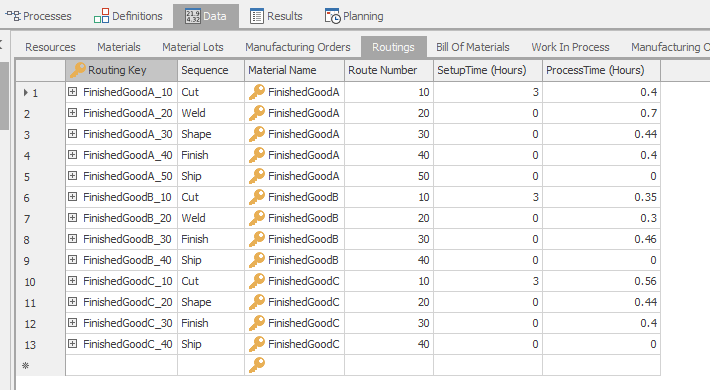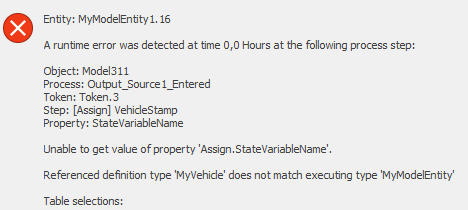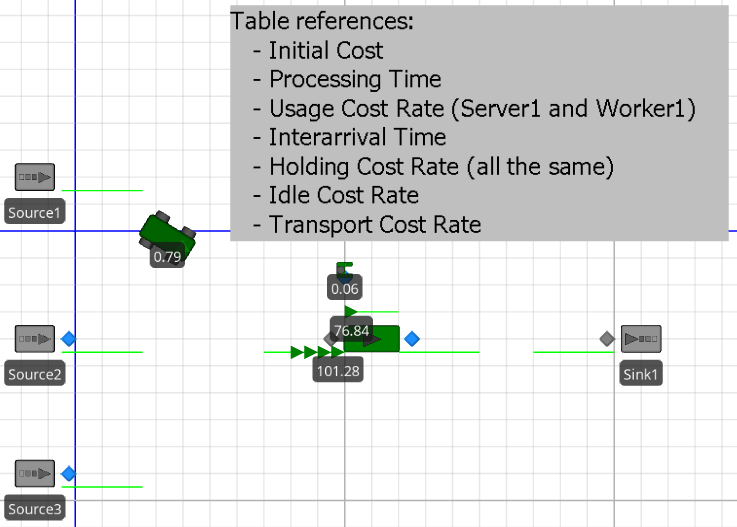Search the Community
Showing results for 'add Queue tto entity like Batch Member'.
-
Hi there, I'm very much a novice, but currently leveraging the logic in VisitAllServersInAnyOrder simbit to ensure an entity visits an entity is never reworked more than once. I've updated the model entity with required state variables and created a "MyServer" to create the "HasEntityVisited" etc etc. I'm using the "Candidate.MyServer.HasEntityVisited==False" logic for the selection condition in the output node routing logic. However, whenever I run the model I get the error message "Referenced definition type "MyServer" does not match executing type "BasicNode". I've gone over and over the various elements and compared to the working simbit, but can't identify the issue. Any help would be greatly appreciated. Thanks in advance. Garrett
-
How can I model where the robot always pick 2 parts and waits until 2 parts are available at output buffer of the server. (Robot is available in extras library). i have multiple servers in the model.
-
Hi! In my model I have entities called "Pedido" which have a state called "id_del_pedido" which is equal to the ID of the entity. These entities will enter a Separator that will create copies of the entity according to a probability distribution. Since the new entities are copies of the parent entity, they will have the same "id_del_pedido" status as the parent entity. Subsequently, the entities created will enter a Server that acts as a warehouse. This Server is linked to a Combiner, when the parent entity reaches the Combiner's parentinput I want only entities whose "id_del_pedido" is equal to the ID of the entity that reached the Combiner's parentinput to leave the server. This works perfectly in the first Server-Combiner set of my model, but, the Combiner's outputnode is attached to another Combiner and I want to repeat the same activity as in the first Combiner but I get an error that I don't know how to solve. I attach my model so that my problem is better understood. Thank you very much in advance! 18.10.spfx
-
Hello Everyone, please can someone help me with this situation? I want to use a Server as a storage place, entities coming out of it go into the MemberInput of a Combiner. I want the number of entities that leave the Server to depend on the state of the entity that will enter the ParentInput of the Combiner. How can I access the state of the parent entity that will enter the combiner from the Output Node of the Server? Thank you very much, Greetings! 14.10.spfx
-

Changing Sequence table over time
Rebecca Obasi replied to antonio6vieira's topic in SI General Discussions
That's because there is a routing table in this case. That's how it was set in this simbit before I made the updates. I also I tried to set the "Routing Table" as the initial sequence for the entity and I'm still getting the same error. -
Hi, I have a bottleneck at the end of my assembly line. I cannot dupplicate that station as my total number of workers is already high. Before hiring, I would like to try and reallocate and have satellite employees. I want to allocate my workers to that station when the input buffer has exceeded one entity. Every worker has to finish the entity they are presently working on at the other stations and the first workers that are done need to go the bottleneck station. The rest of the time, the workers can be allocated based on the smallest distance to the work stations. The bottleneck station usually requests 4 workers. That information is already set up in a table. When there is two entities in queue in that buffer, I want workers to be able to go finish the work and hence increase the processing time by X. I have tried a lot of different things, and all my data is stored in relational tables. Thanks!
-
Hello, I'm working on an emergency department (ED) model where I'm using both nurses and doctors as resources. At the ED, there is a 4:1 Patient to Nurse ratio, meaning that on average, a nurse takes care of 4 patients at the same time. When I was thinking about how to implement this logic on Simio, I looked at this option on the Seize step under Advanced options (you can see it on the picture I attached). I set the Units per Object to 0.25 - because I thought that every time a patient seizes a nurse, it will take out 0.25 out of 1 unit of capacity, instead of taking the whole 1, allowing for 3 other patients to seize her before she is completely busy. However, this doesn't work, because I ran a model trace as I ran the model and the server is ignoring the seize because the "Units per object" is set to 0 (which is not, it's set to 0.25) - the exact model trace comment is: "Ignoring resource release of type Specific 'Nurse'. The required capacity units per object '0' is not a positive quantity.". Therefore, the model ignores the resource seize and processes the entity without the resource. Is this because this property field only works with integers? I thought of a work around by just multiplying my number of nurses by 4 to account for that, but that's not optimal. Would there be any other way of achieving this? Thank you very much for the help!
-
The manufacturing line I am trying to simulate has two servers whose behavior I am having trouble modeling. First, these two servers are in parallel. Second, these servers process units in batches of 14. Third, I need both servers to not start a batch until at least 14 units are present in queue. Lastly, I need to pool the queue for both servers into a single queue. Any help would be appreciated. Thank you!
-
Hello, I'm new to both the forum and the world of simio in general. I am trying to simulate how much the maximum buffer could be in 2 points of my process which are defined by the Buffer_ST1 and Buffer_ST2 servers. My problem is that I would like the Buffer_ST2 server based on a condition that would be every time an entity passes on Input @ Buffer_ST1, the Buffer_ST2 server releases only one processed entity and not all those inside the server as it happens now, I hope for being clear and thank you in advance. I put the model in the attachment Buffer varianti trazioni V2.spfx
-

Changing Sequence table over time
Rebecca Obasi replied to antonio6vieira's topic in SI General Discussions
Ok I can do a trace and see what I find. Also, I do have different entity/job types getting processed. In my routing tables, I do have the entities specified in the table. I'm trying to use the "ChooseAlternateSequence" simbit as a reference. Is it possible to do this if you have more than one entity type? -

Changing Sequence table over time
Rebecca Obasi replied to antonio6vieira's topic in SI General Discussions
I'm trying to do something similar to do this where an order has 4 different routes or paths it can go (My model currently doesn't have paths). I created 3 separate sequence tables and created a process logic depending on if a certain workstation is already processing an order/entity, to go through this sequence. For some reason, whenever it gets to the "set row" step, there is a table reference error mentioning "no entries found" if though in the process step, I specify which row to start the new sequence. What is the reason behind this error? -

Transferring properties between objects
MauricioBiolato replied to FoodEngFAAB's topic in SI General Discussions
Hi Fabian, I see two (or more) possible alternatives for solving this. Assuming that the box only receives one type of entity you can: 1. Create a state variable (for example st_CurrentBoxType) and every time an entity enters the combiner you assign the entity type to this state variable. This way, one the box is completed and exits the combiner you will be able to assign it the st_CurrentBoxType. 2. The other way is to execute a search step once the box is full. You can use "ModelEntity.BatchMembers.FirstItem" as match condition to locate the first batched entity, then in the found branch use an assing step to assign the ProdType from the found entity I'm sure there are a lot of ways of doing that... hope this helps saludos -
Hi I have an entity that is moved through the network via vehicles. The vehicle will drop of the entity at the first server which then gets processed through two servers. I would like to use the vehicle that dropped off the entity at the Input to the first server to be used to pick up the next entity at the output of the second server. Is there a way to save the exact Vehicle that was used and specify that as the Vehicle to use at the second pick up point? Hopefully to a global variable and not to the entity (in my actual model, the entity going in to Server 1 is not the next entity coming out of Server 2). At the moment I am using 'Reserve Closest' as the reservation method at Server 2. I know that is incorrect, but I'm not sure how to setup this up using the other methods. In the attached model, process works for the first entity, but does not for the second entity onwards. Due to other limitations in the model, I need to have the Vehicles to 'Remain in Place' during idle. Thanks in advance for the help. SpecificVehicle.spfx
-
Hi, I want to generate one type of product with one interarrival time. I have one source and one model entity. However, this entity can have different lengths following probabilities. Depending on these properties, the processing times at the servers will be shorter or longer. I tried to assign a state to the entity before this entity exits the source so ModelEntity.Length becomes DataLength.prob.randomrow. where DataLength is a table with the different lengths and the probabilities associated with those Lengths. The only thing is that it is a property and not a state, but I do not know how to do it in another way. Afterwards, I have different processing times at the servers depending on the different characteristics of my entity. For example, server1 will have different processing times depending on the length. How can I reference to the good processing time say I have added a column to the table DataLength with the associated processingtimes according to the lengths? Finally, I would also like keep track of those different lengths generated and see what the model produced in the end. Thank you for your help, Emilie
-
Hi I've got a model where the situation is like this: 1. 3 Worker: W1 W2 W3 2. 3 Server: S1 S2 S3 On Monday (work schedule), W1 will work in S1 in the morning and work in S2 in the afternoon. W2 will work on S2 in the morning and S1 in the afternoon. But on Tuesday, W1 will work in S2 in the morning and S3 in the afternoon. W2 will work in S3 in the morning and S2 in the afternoon. The server properties in the secondary resource are "select from the node list." But since the node list for S1 and S2 contain both W1 and W2, and they both have the same hour of working (4+4), when the S1 server seized the resource on Tuesday morning, instead of W1, W2 got allocated instead( W2 should be in S3). I have tried: 1. Using server selection goal to " smallest distance," but it didn't work since the worker will keep swapping the room every day 2. Giving each worker a new initial value and setting the selection goal to "smallest value," but they still have the issue. 3. Try setting idle action for the worker to stay at the node, but sometimes the worker will go to the wrong destination from the first entity, hence no one working in the other room. (2 worker stay together) Is there any method to realize this idea? Thanks in advance
-
Perhaps its a little late, but attached is a possible solution to your problem. This started out pretty simple. The problem was how to specify which server is serviced by which resource. One way to do that is a table. But since its changing over time I chose to use a time-indexed table, that is a table that knows about time and returns different data at different times. In this case, each row corresponds to 12 hours and each column specifies the resource needed by the respective server. As they say, "the devil is in the detail" and in this case the "devil" is that the specified resource may change between seize and release (e.g., seize at 11:59, release at 12:05). Simio doesn't like that and all the easy options re-evaluate the resource expression on release and so may try to release the wrong resource. One option would have been to create a custom server, but that seems to be overkill. Here is a somewhat simpler approach: 1) Add an entity state named MyResource and assign it at the last possible moment before use. This value will be used only for release. The assigned value is drawn from the table using an expression like Table1.S1Resource.TimeIndexedValue.Object. Note that the .timeindexedvalue indicates to get the value associated with the current time. And the .object at the end is used to tell Simio to return that value as an object not a number. 2) Use Secondary Resources - Other Resource Seizes to seize the name specified in the table using the same expression above Table1.S1Resource.TimeIndexedValue.Object. 3) Use Secondary Resources - Other Resource Releases to release the resource saved in MyResource. TimeBasedWorkerSelection.spfx
-
Well, first thing, you don't need your entities to be bouncing between the output and the input of your server like that. If you want to use it as sort of storage, set both the processing time and the capacity to infinity. After that, at the moment that the parent entity enters the combiner "Parent Entered" you could search the queue of your storage using a search step with something like "Server1.Processing.Contents", with the condition of "Candidate.ModelEntity.State == ModelEntity.State", release the server and transfer what have been found to the output. You need to take some care on some situations, like what if the parent entity arrives first at the combiner then the member at the storage? And some care with batching quantities aswell. But I think you can handle it.
-
Hi , I have a system with a combiner, that combines different variations of batches. On exiting the combiner the crane picks the combined entity up and drops up at a server. Each of the different batches will have a different load and unload time. Is there a way to do this? Basically, does batch contain product ‘A’ if so crane time is ‘X Mins’ Does batch contain product ‘B’ if so crane time is ‘Y Mins’ Thanks for any help!
-
Worker to "empty" queue before moving to next server.
ViniciusF replied to jopendle's topic in SI General Discussions
Hi, One way to do this is put a Dynamic Selection Rule: Smallest Value First on the Worker, with the value expression of: Candidate.Entity.DirectDistanceTo.Object(Worker). This could work. -
Hi All,
In my model, I have a transfer node and the entity could go to either of the next 2 serves as in the picture.
I have assigned product number(1,2,3...) to entities …., if product “1” moves from transfer node to S1 and the next product is also “1”, it should also move to S1 and if the product number changes its should change the server to S2. So the entire batch gets processed on one server.
After processing from S1 and S2 the entity should flow in batch so that at S3 I have batch production
Right now the entities go based on “By Link Weight” and randomly goes to the server which affects S1,S2,S3 servers setup time
Any thoughts how can that be achieved, I do not want to setup a sequence table.
-
Model.spfx Hello, i am trying to stop the transport time for my entity. The process logic is as follows: hen the entity exits the Source output, the time stamp (MyVehicle.Stamp) is assigned with the value "TimeNow". When the transporter drops the entitys to the servers input the time is stopped (New Value = TimeNow- MyVehicle.Stamp) and simio calculates the transport costs. The error is attached. I get the same error, when i use MyModelEntity instead of MyVehicle. The model name is "Model311" in the attached project "Model". How or where do I have to set the stamp correctly? Thank you!
-
Referenced definition type and executing type error
Gashi replied to Gashi's topic in SI General Discussions
Thank you for the model! It took a long time to get the sprint release but now I can see it and it helps. Now I have another problem. I am trying to do a pick up at two different places and the drop off at one destination. There I want to have the transport costs split on the entity with the calculation TransportCostRate/TransportQty. The logic works like this: The transport from Source1 to Source2 (or BasicNode4) should be charged and assigned to ModelEntity.Cost. Then from Source2 to Server1 another calculation should be done, now with the increased transport quantity in dependency. But in BasicNode4 the process is not triggered by the ModelEntity, but by the Transporter. Is there any way that the process is triggered by the passenger? (the entity in the ridestation). The model is in the appendix. Best regards. Model_421.spfx -
Referenced definition type and executing type error
ViniciusF replied to Gashi's topic in SI General Discussions
Hi! I don't think you need to save those times stamps on MyVehicle. I would suggest you to use processes that triggers when the entity leaves the Output Buffer of the source and enters the Input Buffer of the server. To do that, create two process with the corresponding Triggering Event Name: Source1.OutputBuffer.Exited or Server1.InputBuffer.Entered, saving time stamps directly on the MyModelEntity. -
How to track the different values of ModelEntity.Cost
Gashi posted a topic in SI General Discussions
Hello, i am using the Financials Properties in Simio. In this simple model, i have parameters for different cost types (see in the picture). All the cost types are used with the default financial states. The dynamic label of the ModelEntiy shows the expression "ModelEntity.Cost", so it roll all the cost components up in the particular entity. The entity in the processing has a value of 76.84. (rolled up) Now my question is, is it possible to see all the cost components for all my model entity, for example as a expression in a floor label or in a data table. Thank you! -
Hi everybody! I want to know if it is possible that an entity can change from one server to another if the another server is available and the entity isn't still processing. It means if it is possible that an entity can exit from the input buffer of the first server. Thanks for your help. Best, Albert.






